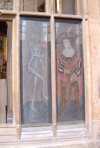For this church:    |
Newark St Mary MagdaleneArchaeology
Significant Interior Features
Timbers and roofs
BellframeCast-iron, low sided frame by Mears and Stainbank of 1913. New fittings installed by Taylors of Loughborough in 1954. Not scheduled for preservation Grade 5. Walls
Excavations and potential for survival of below-ground archaeologySeveral watching briefs have been undertaken during the 1980s and 1990s on minor external works, mainly for the repair of paths and walls (County SMR). A watching brief on the opening-up of the south aisle transept floor for investigation purposes in 1999 revealed no significant pre-C19th archaeological deposits at the surface. No excavation was undertaken (County SMR). The overall potential for the survival of below-ground archaeology in the churchyard is considered high-VERY high and below the present interior floors is considered to be high-VERY high. Exterior:Domestic/ecclesiastical Pre-Conquest-C20th, low incidence of surviving burials likely on all sides due to proximity of streets and walkways. Interior:Extent of C19th disturbance is conjectural. Vaults known to exist and whole is likely to be a highly complex mixture of C15th building layers with unknown survival of earlier deposits beneath, punctuated by late medieval graves and post-medieval vaults. Walls:Mostly C15th rebuilding and subsequent alterations, but earlier evidence apparent at the west end and in the crypt. |


 Earliest core fabric
is the
Earliest core fabric
is the 



